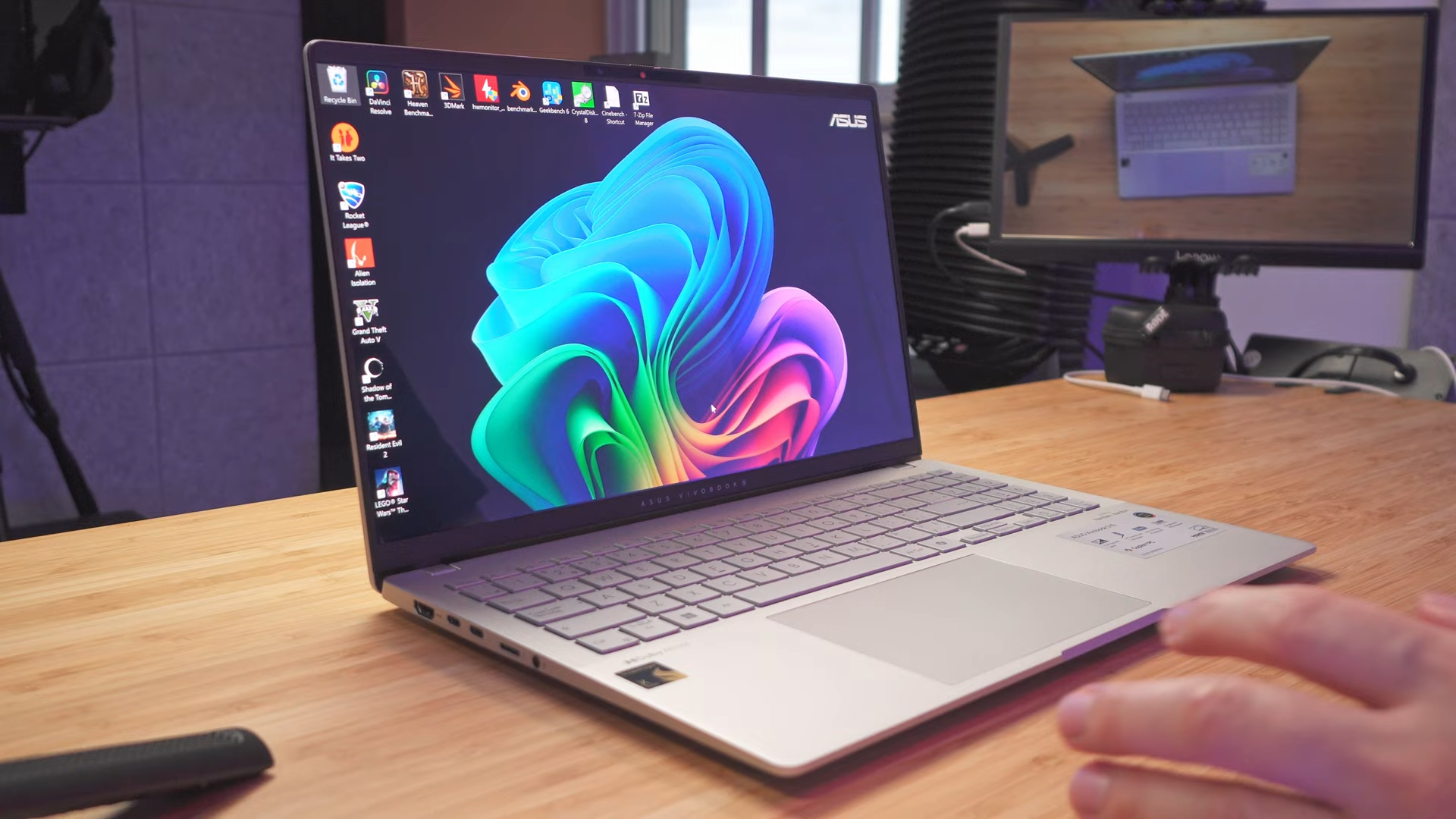Snapdragon X Elite with liquid metal thermal paste yields disappointing results
Maximum CPU temperatures decrease by two degrees with the liquid metal application.

Reviewer High Tech Point recently reviewed Asus' Vivobook S15 Copilot+ PC powered by Qualcomm's Snapdragon X Elite processor. The reviewer was underwhelmed by the laptop's thermal performance, which provided high CPU thermals in higher power profiles and warm surface temperatures even under lighter use. To cope with this temperature behavior, the reviewer swapped the thermal paste application from regular paste to liquid metal to see if the more thermally efficient material would help alleviate the Vivobook S15's thermal behavior.
Unfortunately, High Tech Point discovered that the liquid metal application did little to improve performance and temperatures. In Cinebench testing, the stock thermal paste application yielded a 10,962-point multi-threaded score, while the liquid metal application yielded a 3% improvement of 11,344 points. Thermals were much the same. The Snapdragon X Elite's maximum temperature dropped by two degrees with the liquid metal application, going from a maximum temperature of 88 degrees Celsius from two CPU sensors to 86 degrees Celsius.
We aren't surprised at these underwhelming results. Despite its excellent thermal characteristics, liquid metal isn't a magic pill that can solve all thermal issues in one fell swoop. One attribute of modern-day processors that helps prevent cooling modifications from reducing temperatures is how most modern CPUs boost clock speeds; generally, when there is voltage, thermal, and power headroom to spare, a CPU boosts the clock speed, maximizing performance wherever possible. It is why temperatures only decreased by two degrees while performance increased (albeit only 3%).
It is fantastic for performance reasons and means that most CPUs leave nothing on the table regarding clock speed headroom. The downside is that this behavior can lead to hotter temperatures, which might not be comfortable for the user, mainly if it translates into warm surface temperatures.
Switching thermal paste applications, even to liquid metal, can only do so much. Good thermal contact must be accompanied by a good cooling solution to improve temperatures. Asus prioritizes lightness and thinness with the Vivobook S15, so the laptop manufacturer went with a cooling solution as small as possible. This solution will still deliver suitable surface temperatures while keeping the CPU cool enough to provide good performance.
The good news is that you can alter this behavior on the Vivobook S15 if you sacrifice performance. High Tech Point reports that switching to the balanced or performance profiles only yields the aforementioned thermal issues. Switching the laptop to power efficiency mode rectifies the problem altogether. We aren't sure if the laptop's high surface temperatures are average — Tech High Pont recorded a maximum surface temp of 46.6 degrees Celsius on the keyboard — particularly in the laptop's balanced profile, which most people will be using. But it's worth mentioning that this laptop just came out, so Asus might provide a new firmware update that further optimizes the cooling and performance.
Get Tom's Hardware's best news and in-depth reviews, straight to your inbox.

Aaron Klotz is a contributing writer for Tom’s Hardware, covering news related to computer hardware such as CPUs, and graphics cards.
-
Notton A few thoughtsReply
Use Honeywell PTM7950, what is this, 2018?
It's only hitting 88C in a thin and light, which is perfectly acceptable
Are we sure it's actually 88C? I thought temp/power/usage monitoring software wasn't working on this chip just yet
It seems to be boosting higher/longer to fill in any gains from the improved thermal performance.
Try pointing a large fan at the bottom and see if there is any extra performance to be gained by improving the cooling
Slapping on liquid metal is the last thing I would have tried.
Taking the bottom cover off and blasting a large fan at it would be my first choice. -
bit_user Yeah, I'd say a few % performance improvement + 2 degree peak temperature reduction is actually pretty good for just replacing the thermal compound. As @Notton suggested, the chassis is probably heat-soaked and really just needs a beefier cooler and/or better ventilation.Reply -
Amdlova its why I use a rubber case on my s23... with power savings all the time...Reply
Qualcomm CPU it's good to fry a EGG on it. In summer when reach 40 c the phone become a finger print remover.
Bad intel cpus now your time to shine over this ARM afterburner -
HideOut ReplyNotton said:A few thoughts
Use Honeywell PTM7950, what is this, 2018?
It's only hitting 88C in a thin and light, which is perfectly acceptable
Are we sure it's actually 88C? I thought temp/power/usage monitoring software wasn't working on this chip just yet
It seems to be boosting higher/longer to fill in any gains from the improved thermal performance.
Try pointing a large fan at the bottom and see if there is any extra performance to be gained by improving the cooling
Slapping on liquid metal is the last thing I would have tried.
Taking the bottom cover off and blasting a large fan at it would be my first choice.
yep, im sure most users would get a thin/light and do the remove parts thing. That'll work great on the train on the way to work or home. -
tamalero Reply
Even less people would use liquid metal...HideOut said:yep, im sure most users would get a thin/light and do the remove parts thing. That'll work great on the train on the way to work or home. -
CmdrShepard Reply
All the risks associated with liquid metal application are hardly worth those 2-3% gain.bit_user said:Yeah, I'd say a few % performance improvement + 2 degree peak temperature reduction is actually pretty good for just replacing the thermal compound. As @Notton suggested, the chassis is probably heat-soaked and really just needs a beefier cooler and/or better ventilation.
It seems that nowadays people don't get basic laws of physics -- smaller surface => worse heat transfer, and Snapdragon has even less die surface than Intel notebook let alone desktop CPUs which are already hard enough to cool. -
bit_user Reply
But it doesn't clock as high.CmdrShepard said:It seems that nowadays people don't get basic laws of physics -- smaller surface => worse heat transfer, and Snapdragon has even less die surface than Intel notebook let alone desktop CPUs which are already hard enough to cool.
Also, I think it's using the same process as AMD's phoenix APUs. I'll bet the core sizes are pretty similar, too. -
Kondamin Petty they didn’t launch a small desktop version equipped with a decent heat sink and fanReply -
das_stig "Asus might provide a new firmware update that further optimizes the cooling and performance" - another pre-scripted excuse!!Reply
Reviews and reporters need to stop, making excuses for manufacturers of rubbish equipment, if the Snap-X and the Vivo is too slow, runs too hot and has poor cooling to save a few pennies on the BOM, then say so. Your supposed to do these reviews/reportsf on behalf of consumers so we don't get ripped off and have know what to expect.
Unless your too chicken sh!t and no longer independently unbiased, preferring to keep the manufacturers happy for access to products to report on, resulting in advertising sales??? -
Notton Reply
They are benchmarking it. They had to remove the bottom cover to apply liquid metal in the first place.HideOut said:yep, im sure most users would get a thin/light and do the remove parts thing. That'll work great on the train on the way to work or home.
Why don't you read the article?